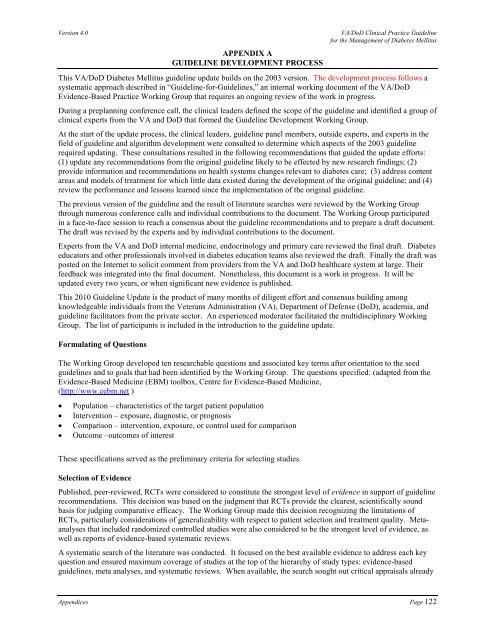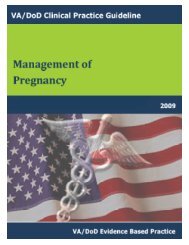DM Full Guideline (2010) - VA/DoD Clinical Practice Guidelines Home
DM Full Guideline (2010) - VA/DoD Clinical Practice Guidelines Home
DM Full Guideline (2010) - VA/DoD Clinical Practice Guidelines Home
Create successful ePaper yourself
Turn your PDF publications into a flip-book with our unique Google optimized e-Paper software.
Version 4.0<br />
APPENDIX A<br />
GUIDELINE DEVELOPMENT PROCESS<br />
<strong>VA</strong>/<strong>DoD</strong> <strong>Clinical</strong> <strong>Practice</strong> <strong>Guideline</strong><br />
for the Management of Diabetes Mellitus<br />
This <strong>VA</strong>/<strong>DoD</strong> Diabetes Mellitus guideline update builds on the 2003 version. The development process follows a<br />
systematic approach described in “<strong>Guideline</strong>-for-<strong>Guideline</strong>s,” an internal working document of the <strong>VA</strong>/<strong>DoD</strong><br />
Evidence-Based <strong>Practice</strong> Working Group that requires an ongoing review of the work in progress.<br />
During a preplanning conference call, the clinical leaders defined the scope of the guideline and identified a group of<br />
clinical experts from the <strong>VA</strong> and <strong>DoD</strong> that formed the <strong>Guideline</strong> Development Working Group.<br />
At the start of the update process, the clinical leaders, guideline panel members, outside experts, and experts in the<br />
field of guideline and algorithm development were consulted to determine which aspects of the 2003 guideline<br />
required updating. These consultations resulted in the following recommendations that guided the update efforts:<br />
(1) update any recommendations from the original guideline likely to be effected by new research findings; (2)<br />
provide information and recommendations on health systems changes relevant to diabetes care; (3) address content<br />
areas and models of treatment for which little data existed during the development of the original guideline; and (4)<br />
review the performance and lessons learned since the implementation of the original guideline.<br />
The previous version of the guideline and the result of literature searches were reviewed by the Working Group<br />
through numerous conference calls and individual contributions to the document. The Working Group participated<br />
in a face-to-face session to reach a consensus about the guideline recommendations and to prepare a draft document.<br />
The draft was revised by the experts and by individual contributions to the document.<br />
Experts from the <strong>VA</strong> and <strong>DoD</strong> internal medicine, endocrinology and primary care reviewed the final draft. Diabetes<br />
educators and other professionals involved in diabetes education teams also reviewed the draft. Finally the draft was<br />
posted on the Internet to solicit comment from providers from the <strong>VA</strong> and <strong>DoD</strong> healthcare system at large. Their<br />
feedback was integrated into the final document. Nonetheless, this document is a work in progress. It will be<br />
updated every two years, or when significant new evidence is published.<br />
This <strong>2010</strong> <strong>Guideline</strong> Update is the product of many months of diligent effort and consensus building among<br />
knowledgeable individuals from the Veterans Administration (<strong>VA</strong>), Department of Defense (<strong>DoD</strong>), academia, and<br />
guideline facilitators from the private sector. An experienced moderator facilitated the multidisciplinary Working<br />
Group. The list of participants is included in the introduction to the guideline update.<br />
Formulating of Questions<br />
The Working Group developed ten researchable questions and associated key terms after orientation to the seed<br />
guidelines and to goals that had been identified by the Working Group. The questions specified: (adapted from the<br />
Evidence-Based Medicine (EBM) toolbox, Centre for Evidence-Based Medicine,<br />
(http://www.cebm.net )<br />
• Population – characteristics of the target patient population<br />
• Intervention – exposure, diagnostic, or prognosis<br />
• Comparison – intervention, exposure, or control used for comparison<br />
• Outcome –outcomes of interest<br />
These specifications served as the preliminary criteria for selecting studies.<br />
Selection of Evidence<br />
Published, peer-reviewed, RCTs were considered to constitute the strongest level of evidence in support of guideline<br />
recommendations. This decision was based on the judgment that RCTs provide the clearest, scientifically sound<br />
basis for judging comparative efficacy. The Working Group made this decision recognizing the limitations of<br />
RCTs, particularly considerations of generalizability with respect to patient selection and treatment quality. Metaanalyses<br />
that included randomized controlled studies were also considered to be the strongest level of evidence, as<br />
well as reports of evidence-based systematic reviews.<br />
A systematic search of the literature was conducted. It focused on the best available evidence to address each key<br />
question and ensured maximum coverage of studies at the top of the hierarchy of study types: evidence-based<br />
guidelines, meta analyses, and systematic reviews. When available, the search sought out critical appraisals already<br />
Appendices Page 122
















